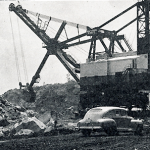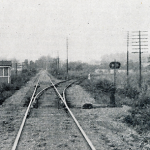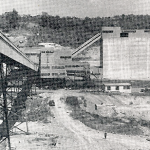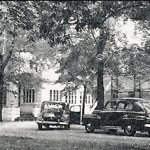Submitted by Dennis Carnal
This is the first in a series of articles and photographs linking coal mining and the L&N Railroad during the 1930s till the 1970s. We will start with an article covering the first coal mine in Hopkins County to produce over two million tones of coal in one year. This production was done by the somewhat new use of surface or strip mining. Strip mining was a much cheaper way to mine coal during this time period, than underground mining.
The mine covered by this article was the Homestead Coal Company, opened during 1946. The coal reserves in this area were owned by The West Kentucky Coal Company. The area covered by this mine was bordered by Highway 41 between Earlington and Nortonville on the east. By Highways 112 and 454 between Earlington and St. Charles on the north and west. By Highway 62 between Nortonville and St. Charles on the south. The area north of St. Charles had been mined by the Fox Run Mine during the early 1900s.
The coal was mined by two electric power shovels. One shovel built by the Bucyrus-Erie Company had a 35 cubic yard bucket. The other shovel was built by the Marion machinery company and had a 20 cubic yard bucket.

In June 1955, Peabody Coal Company purchased Homestead Coal Company. In 1955, employment and production peaked. During 1955, 240 miners produced 2,307,557 tons of coal. Employment and production totals dropped until 1959, when the mine closed and all remaining equipment was moved to the newer White City mine, east of Mortons Gap.
Now, please read excerpts from a story covering the Homestead Mine from the September 1948 issue of the L&N Magazine. Next month look for a story from the October 1956 issue of the L&N Magazine about a 1,200 ton monster movement over the L&N Henderson Subdivision between Mortons Gap and Nortonville.
Homestead mine is one of the newest and largest coal mines served by the Old Reliable. It is not the only strip, or open-pit mine on our lines, although these are comparatively few, but it is certainly the most impressive. It is located in Hopkins County, down in Western Kentucky near Nortonville, and is served by our Homestead Branch, which was completed in the later part of 1946. This 4.74-mile long spur is an offshoot of the Evansville-Nashville line and about one-third of it was built jointly with the Illinois Central, which thus also services the development.

Homestead Mine was placed in operation shortly after the completion of the Branch and ever since has been funneling a cascade of high-grade bituminous coal into our waiting cars. (It has a rating of 9,000 tons, or 180 cars per day.)
The seams being mined at Homestead are the No. 11 and No. 12 ones, the No. 9 seam, further on down in the bosom of the earth, generally having already been mined by underground methods throughout the area. Atop the No. 12 is some 50 to 80 feet of overburden. The No. 12 seam, which averages around four and one-half feet thick, is separated from the No. 11 seam, which runs around six and one-half feet thick, by about seven to eight feet of limestone rock. Hence, before the seams can be mined, some changes obviously have to be made.
An essential ingredient in the strip mining of coal at Homestead is “Buster,” a “million-dollar baby’” produced by the Bucyrus-Erie people, who have long specialized in the manufacture of custom-built, heavy-duty excavating machinery. “Buster” – an appellation originating with the writer, is a giant, electrically-operated shovel, towering some 100 feet above the ground and weighing some 1,600 tons. It removes the overburden in huge, 35-cubic yard bites, piling the rock and earth expertly to one side in small-sized Alps, and inching its way forward between munches at the rate of about one-tenth of a mile an hour. (Incidentally, it took 46 freight cars to transport the component parts of this colossus to Homestead for assembly.)
The giant shovel is followed by bulldozers which remove the miscellaneous debris which escape the former’s maw. Then a smaller edition of “Buster,” but Diesel-powered, moves in to mine the coal, scooping it up and dumping it 15 to 20 tons at a time into the waiting trucks, some of which have a capacity as great as 40 tons.
The trucks roar away to a dumping apron atop the head end of a conveyor belt—the reception room of a “beauty shop” some 600 feet distant. The belt, which is trestled across the valley in an enclosed structure, trundles the coal along at a fast rate of speed to the cleaning and preparation plant, whose attractive buildings resemble some huge, modernistic hotel. Here an inky Niagara of coal, seemingly sufficient to feed the furnaces of all the nation’s homes and industries, dumps continuously on a jiggling apron of steel, punched with holes of varying sizes, like a bagatelle board. This separates the coal into three sizes prior to washing, and watchful eyes and expert hands remove debris such as sticks, rock, and the like, which are surprisingly rare at that.
Generally speaking, coal is lighter than its accompanying impurities. Hence, a system of “floating” the coal and “sinking” the impurities is effectively used at Homestead to separate the coal from its dross. This is done by passing the coal through rushing streams of chemically-treated water, the chemicals, i.e.., calcium chloride, zinc chloride, and the like, hastening the separation process.

The refuse coal, etc., is conveyed back across the valley for dumping by another conveyor belt. The raw coal loses from 15 to 18 percent of its weight in the washing and cleaning process.
After the coal has parted company with its “fellow travelers” the moisture is removed by an automatic de-watering and drying system and the coal is then further screened into various sizes—lump, egg, nut, and slack – for special uses—industrial, domestic, steam plant, stoker, and so on.
Not over 30 minutes have elapsed since it was first scooped from the ground. Some of it is placed in storage but most is promptly conveyed by gravity into the waiting coal cars of the Old Reliable—or of the Illinois Central. (at present writing we are hauling about 2/3s of the tonnage.) Here again gravity supplies the motive power, delivering the cars onto one of the tracks of a six-track storage yard with a capacity of 150 cars. Mine runs then haul the hoppers into the make-up yard at Earlington, KY, and the long, solid coal trains are soon rumbling their way north, east, south and west.

On August 18 (1948), it (West Kentucky Coal) moved its general offices from Earlington into a modern, spacious and air-conditioned three-story structure at Madisonville (present day Multicare facility). Here 75 employees will continue to guide and direct the destinies of a business whose output in 1947 was topped by only 18 other coal producers in the entire country.
